Java exception handling
- 2. Exception Handling • An exception is an abnormal condition that arises in a code sequence at run time. • In other words, an exception is a run-time error. • Exceptions can be generated by the Java run- time system, or they can be manually generated by your code.
- 3. • Exceptions thrown by Java relate to fundamental errors that violate the rules of the Java language or the constraints of the Java execution environment. • Manually generated exceptions are typically used to report some error condition to the caller of a method. • Java exception handling is managed via five keywords: try, catch, throw, throws, and finally
- 4. • The general form : try { // block of code to monitor for errors } catch (ExceptionType1 exOb) { // exception handler for ExceptionType1 } catch (ExceptionType2 exOb) { // exception handler for ExceptionType2 } // ... finally { // block of code to be executed before try block ends }
- 5. • All exception types are subclasses of the built- in class Throwable. • Exception, Error are the subclasses of Throwable class.
- 6. Exception • This is also the class that you will subclass to create your own custom exception types. • Eg: division by zero invalid array indexing.
- 7. Error • which defines exceptions that are not expected to be caught under normal circumstances by your program. • Eg: Stack overflow
- 8. Using try and catch • exception handler allows you to fix the error. Second, it prevents the program from automatically terminating. • To guard against and handle a run-time error, simply enclose the code that you want to monitor inside a try block.
- 9. • If an exception occurs within the try block, it is thrown. • Your code can catch this exception (using catch) and handle it in some rational manner.
- 10. Sample class Exc2 { public static void main(String args[]) { int d, a; try { // monitor a block of code. d = 0; a = 42 / d; System.out.println("This will not be printed."); } catch (ArithmeticException e) { // catch divide-by-zero error System.out.println("Division by zero."); } System.out.println("After catch statement."); } }
- 11. • Output: Division by zero. After catch statement. • Once an exception is thrown, program control transfers out of the try block into the catch block. • Once the catch statement has executed, program control continues with the next line in the program following the entire try/catch mechanism.
- 12. • The statements that are protected by try must be surrounded by curly braces.
- 13. Displaying a Description of an Exception • Throwable overrides the toString( ) method (defined by Object) so that it returns a string containing a description of the exception.
- 14. Multiple catch Clauses • In some cases, more than one exception could be raised by a single piece of code. • To handle this type of situation, you can specify two or more catch clauses, each catching a different type of exception. • After one catch statement executes, the others are bypassed, and execution continues after the try/catch block
- 15. Sample class MultiCatch { public static void main(String args[]) { try { int a = args.length; System.out.println("a = " + a); int b = 42 / a; int c[] = { 1 }; c[42] = 99; } catch(ArithmeticException e) { System.out.println("Divide by 0: " + e); } catch(ArrayIndexOutOfBoundsException e) { System.out.println("Array index oob: " + e); } System.out.println("After try/catch blocks."); } }
- 16. • When you use multiple catch statements, it is important to remember that exception subclasses must come before any of their superclasses.
- 17. • Checked exceptions : – Checked Exceptions forces programmers to deal with the exception that may be thrown. – Checked exceptions must be caught at compile time. • Unchecked exceptions: – Unchecked exceptions , however, the compiler doesn’t force the programmers to either catch the exception or declare it in a throws clause.
- 18. Nested try Statements • The try statement can be nested. • Sample class NestTry { public static void main(String args[]) { try { int a = args.length; /* If no command-line args are present, the following statement will generate a divide-by-zero exception. */ int b = 42 / a; System.out.println("a = " + a); try { // nested try block /* If one command-line arg is used, then a divide-by-zero exception will be generated by the following code. */ if(a==1) a = a/(a-a); // division by zero
- 19. /* If two command-line args are used, then generate an out-of-bounds exception. */ if(a==2) { int c[] = { 1 }; c[42] = 99; // generate an out-of-bounds exception } } catch(ArrayIndexOutOfBoundsException e) { System.out.println("Array index out-of-bounds: " + e); } } catch(ArithmeticException e) { System.out.println("Divide by 0: " + e); } } }
- 20. • Output: C:>java NestTry Divide by 0: java.lang.ArithmeticException: / by zero C:>java NestTry One a = 1 Divide by 0: java.lang.ArithmeticException: / by zero C:>java NestTry One Two a = 2 Array index out-of-bounds: java.lang.ArrayIndexOutOfBoundsException
- 21. throw • It is possible for your program to throw an exception explicitly, using the throw statement. • The general form : throw ThrowableInstance; • ThrowableInstance must be an object of type Throwable or a subclass of Throwable.
- 22. • The flow of execution stops immediately after the throw statement; any subsequent statements are not executed. • The nearest enclosing try block is inspected to see if it has a catch statement that matches the type of the exception.
- 23. Sample class ThrowDemo { static void demoproc() { try { throw new NullPointerException("demo"); } catch(NullPointerException e) { System.out.println("Caught inside demoproc."); } } public static void main(String args[]) { try { demoproc(); } catch(NullPointerException e) { System.out.println("Recaught: " + e); } } }
- 24. throws • If a method is capable of causing an exception that it does not handle, it must specify this behaviour so that callers of the method can guard themselves against that exception. • You do this by including a throws clause in the method’s declaration. • The general form: – type method-name(parameter-list) throws exception-list – { – // body of method – }
- 25. class ThrowsDemo { static void throwOne() throws IllegalAccessException { System.out.println("Inside throwOne."); throw new IllegalAccessException("demo"); } public static void main(String args[]) { try { throwOne(); } catch (IllegalAccessException e) { System.out.println("Caught " + e); } } }
- 26. finally • Any code that absolutely must be executed before a method returns is put in a finally block. • The finally block will execute whether or not an exception is thrown. • This can be useful for closing file handles and freeing up any other Resources. • The finally clause is optional.
- 27. Sample class FinallyDemo { // Through an exception out of the method. static void procA() { try { System.out.println("inside procA"); throw new RuntimeException("demo"); } finally { System.out.println("procA's finally"); } }
- 28. Java’s Built-in Exceptions • unchecked exceptions - because the compiler does not check to see if a method handles or throws these exceptions. • checked exceptions- Java defines several other types of exceptions that relate to its various class libraries
- 31. Creating Your Own Exception Subclasses • To create your own exception types to handle situations specific to your applications, to do so just define a subclass of Exception.
- 32. Sample class MyException extends Exception { private int detail; MyException(int a) { detail = a; } public String toString() { return "MyException[" + detail + "]"; } } class ExceptionDemo { static void compute(int a) throws MyException { System.out.println("Called compute(" + a + ")");
- 33. if(a > 10) throw new MyException(a); System.out.println("Normal exit"); } public static void main(String args[]) { try { compute(1); compute(20); } catch (MyException e) { System.out.println("Caught " + e); } } }
- 34. Chained Exceptions • The chained exception feature allows you to associate another exception with an exception.

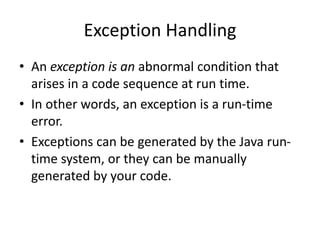







![Sample
class Exc2 {
public static void main(String args[]) {
int d, a;
try { // monitor a block of code.
d = 0;
a = 42 / d;
System.out.println("This will not be printed.");
} catch (ArithmeticException e) { // catch divide-by-zero error
System.out.println("Division by zero.");
}
System.out.println("After catch statement.");
}
}](https://image.slidesharecdn.com/java-exceptionhandling-200318155845/85/Java-exception-handling-10-320.jpg)

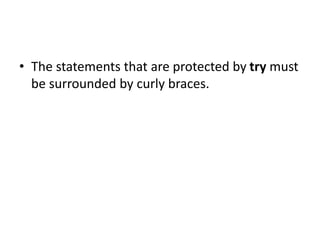


![Sample
class MultiCatch {
public static void main(String args[]) {
try {
int a = args.length;
System.out.println("a = " + a);
int b = 42 / a;
int c[] = { 1 };
c[42] = 99;
} catch(ArithmeticException e) {
System.out.println("Divide by 0: " + e);
} catch(ArrayIndexOutOfBoundsException e) {
System.out.println("Array index oob: " + e);
}
System.out.println("After try/catch blocks.");
} }](https://image.slidesharecdn.com/java-exceptionhandling-200318155845/85/Java-exception-handling-15-320.jpg)


![Nested try Statements
• The try statement can be nested.
• Sample
class NestTry {
public static void main(String args[]) {
try {
int a = args.length;
/* If no command-line args are present, the following statement will
generate a divide-by-zero exception. */
int b = 42 / a;
System.out.println("a = " + a);
try { // nested try block
/* If one command-line arg is used, then a divide-by-zero exception
will be generated by the following code. */
if(a==1) a = a/(a-a); // division by zero](https://image.slidesharecdn.com/java-exceptionhandling-200318155845/85/Java-exception-handling-18-320.jpg)
![/* If two command-line args are used,
then generate an out-of-bounds exception. */
if(a==2) {
int c[] = { 1 };
c[42] = 99; // generate an out-of-bounds exception
}
} catch(ArrayIndexOutOfBoundsException e) {
System.out.println("Array index out-of-bounds: " + e);
}
} catch(ArithmeticException e) {
System.out.println("Divide by 0: " + e);
}
}
}](https://image.slidesharecdn.com/java-exceptionhandling-200318155845/85/Java-exception-handling-19-320.jpg)



![Sample
class ThrowDemo {
static void demoproc() {
try {
throw new NullPointerException("demo");
} catch(NullPointerException e) {
System.out.println("Caught inside demoproc.");
}
}
public static void main(String args[]) {
try {
demoproc();
} catch(NullPointerException e) {
System.out.println("Recaught: " + e);
}
} }](https://image.slidesharecdn.com/java-exceptionhandling-200318155845/85/Java-exception-handling-23-320.jpg)
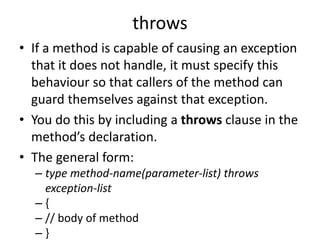
![class ThrowsDemo {
static void throwOne() throws IllegalAccessException {
System.out.println("Inside throwOne.");
throw new IllegalAccessException("demo");
}
public static void main(String args[]) {
try {
throwOne();
} catch (IllegalAccessException e) {
System.out.println("Caught " + e);
}
} }](https://image.slidesharecdn.com/java-exceptionhandling-200318155845/85/Java-exception-handling-25-320.jpg)
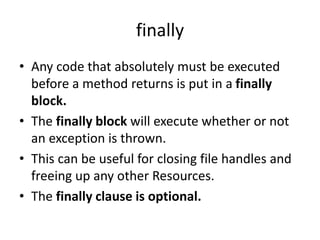

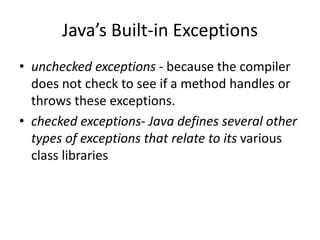


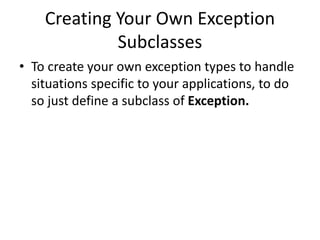
![Sample
class MyException extends Exception {
private int detail;
MyException(int a) {
detail = a;
}
public String toString() {
return "MyException[" + detail + "]";
}
}
class ExceptionDemo {
static void compute(int a) throws MyException {
System.out.println("Called compute(" + a + ")");](https://image.slidesharecdn.com/java-exceptionhandling-200318155845/85/Java-exception-handling-32-320.jpg)
![if(a > 10)
throw new MyException(a);
System.out.println("Normal exit");
}
public static void main(String args[]) {
try {
compute(1);
compute(20);
} catch (MyException e) {
System.out.println("Caught " + e);
}
} }](https://image.slidesharecdn.com/java-exceptionhandling-200318155845/85/Java-exception-handling-33-320.jpg)
